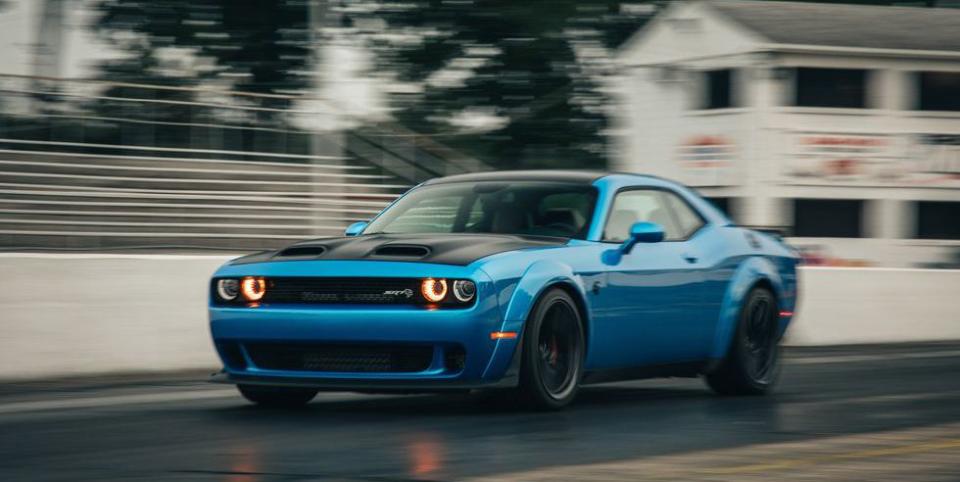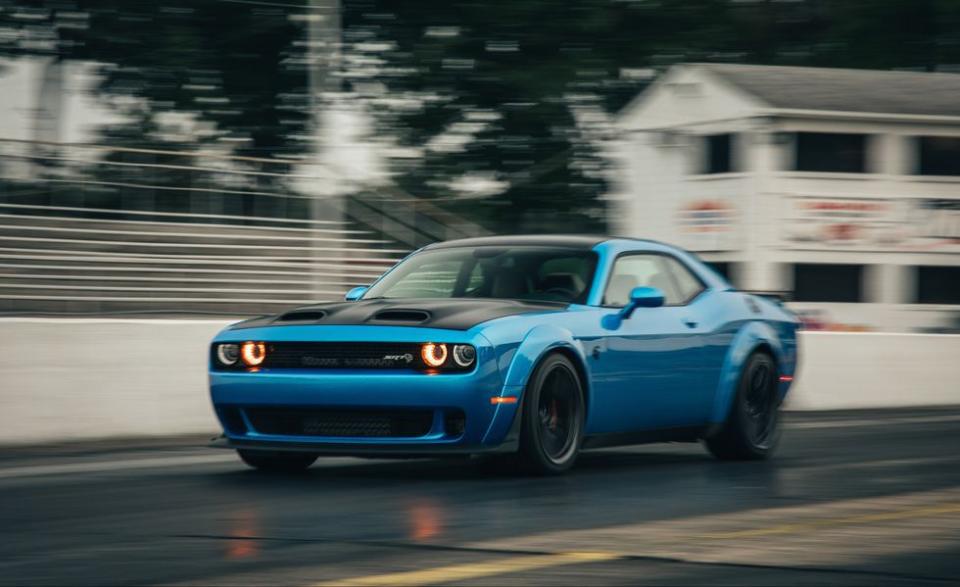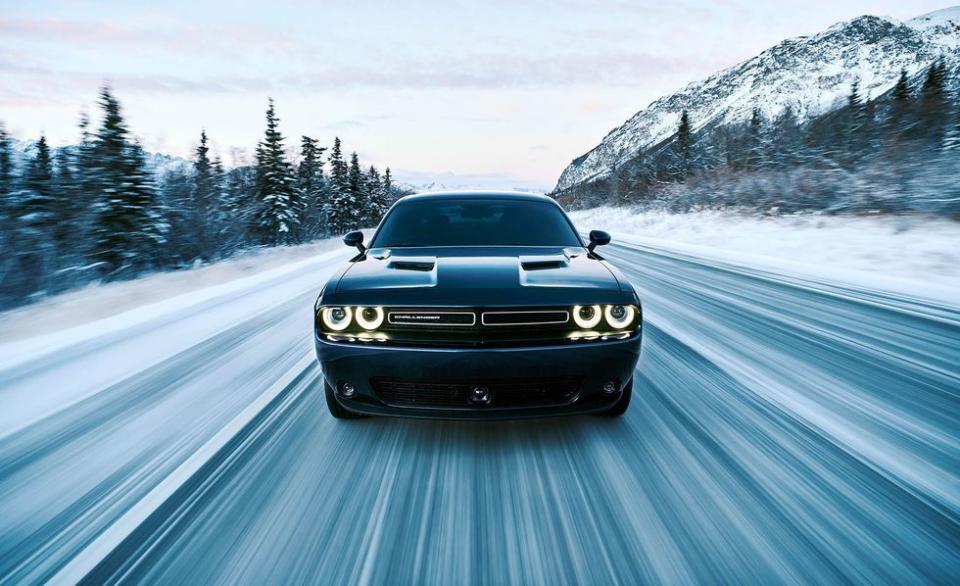Dodge Challenger Points the Way

Remember 2008? Of course you do; it was memorably awful. The economy was in meltdown, banks collapsed, home values dive bombed and the few consumers whose confidence wasn't shaken were those whose confidence was shattered. And into this maelstrom of economic suck and insecurity, Dodge launched the enormous Challenger two-door coupe (above). It was the wrong car at the wrong time.
Except that it wasn't. With a bare few evolutionary changes, the Challenger is improbably now in its 12th year of production and during the 2018 model year it sold better than ever before. It's still a pure retro play; all archaic engineering and spit-into-the-wind muscle marketing. An enormous carbon-slurping coupe at a time when the market is supposed to be headed toward hybrid transportation modules and electric crossovers. Seemingly, this all makes no sense.
"While we may not have invested in an entirely new platform," explains Steve Beahm, "we have done a nice job investing in the platform we have." Beahm's title alone fills up a third of the Internet-Head of Passenger Car Brands, Dodge//SRT, Chrysler and FIAT, and Head of Parts and Service (Mopar) – FCA North America. He rattles off the highlights: "We launched in model year 2008 as an SRT8. Behind that, we came out in 2015 with the Hellcat. Then after that we came out with the Scat Pack. That was in '16. Then in '17 we actually did all-wheel drive. In '18 we had the Demon. And in '19 we had the Red Eye. There were other things that were sprinkled in among that, but the reality is we continue to provide investment after investment into the Challenger to keep it relevant. To keep it available for people across all price classes. We try to keep it where it fits everyone."

All the variations on the Challenger have done a great job of goosing interest on a car whose sell-by date passed a decade ago. But the ongoing success of the car should be understood in context. And that context is probably a better indicator of where the car market is now and where it's headed in the near-future than any fantasies about the imminence of autonomous driving and the sure death of internal combustion.
Part of that context is keeping in mind that the Challenger's success is relative. Dodge dealers sold 66,716 copies of the coupe last year compared to the 75,842 Mustangs Ford sold, and the 50,963 Camaros that Chevrolet moved. What's impressive there is that the Challenger is available only as a hard-roofed coupe while the Ford and Chevy are also offered as convertibles. And both the Camaro and Mustang are much newer designs.
Also in context is that 66,716 is an F-150 production rounding error for Ford. It is, however, still a lot of big coupes with doors long enough to be used as medieval trebuchet arms. The market has atomized and while there are still overwhelming players like the full-size pickups out there, most vehicles are filling niches. And niches, the Challenger demonstrates, can be very profitable over a long period.
"We still sell more (base V6) SXTs," says Beahm. "High performance represents about 27-percent of our sales. We consider high performance to be Scat Pack and above." Putting aside offers and discounts for a moment, the SXT starts at $29,340 including a near-extortionate $1495 destination fee. The Scat Pack starts at $40,490, the Hellcat begins at $62,190, and the Hellcat Red Eye is way up at $73,190. That's an astonishing $43,850 spread from the least expensive Challenger up to the geosynchronous pricing of the 797-horsepower Red Eye.

FCA isn't going to share how much profit is any particular Challenger, but there can't be much in the SXT and there has to be a lot in a Red Eye. Let's guesstimate that there's $1000 of profit in every SXT and at least $5000 in Scat Pack cars and perhaps $20,000 in a Red Eye. If 27-percent of Challenger sales are Scat Pack or better-that's more than 18,000 cars-it almost doesn't matter if there's a dime's worth of combined net profit in all the SXTs.
Much of the Challenger's enduring appeal comes from the fact that when someone comes in to look at a Hellcat, if that customer can't afford it, they can drive away in an SXT on a $199 a month lease, or carry the credit rating to finance a GT or R/T. But when the customer can afford that Hellcat, the profits rain down. "Someone does come in looking for that Scat Pack or Hellcat, maybe they can't afford it price-wise, they still walk out in a great looking car that has 300-horsepower instead of 717 or 485," Beahm says.
The sheer breadth of the Challenger range means there's one for practically anyone who wants one. And why do they want one? Because, and this is a subjective assumption, first is that the Challenger is an utterly gorgeous and timeless design. Its hood is almost pornographically long, the roof is low, and the tail raises up with the lurid provocation of a baboon's butt. In a world where most cars are designed around aerodynamic efficiency and economic optimization, the Challenger is a glorious barn door with separate round headlights, a blunt nose and indulgent design details.
While the current Challenger was designed to evoke memories of the original 1970 Challenger, the newer one is actually better looking. And 12 years in, it still looks fresh.
Beyond that, what matters to us here at Car and Driver doesn't seem to matter much to the buyers. Camaros and Mustangs are nimble and effective on a race track. The big Dodge, on the other hand, uses a cut-down version of Chrysler's LX platform which, in turn, can trace some of its basic engineering back to Mercedes sedans back when DaimlerChrysler was still a thing. It's not built for racetrack use; it's a plush-riding big car. It's great at chasing horizons, not championships.
That it's big means the rear seat is sort of useful, the trunk is useful-ish, and that it's an easy car to get in and out of. The Challenger won't win many comparo titles here at C/D, but few of its buyers will ever care.

Cars, those things that aren't trucks, SUVs or crossovers, are an endangered species. But it's the Dodge Challenger, old soldier that it is, that indicates what the future of cars may be. There will be keenly priced versions at the low-end and monster-profit variants at the high end with the middle muddle of the ranges almost disappearing. They'll have to be high-style and make unapologetically emotional appeals with attributes such as nostalgia or provocative sensuality to attract buyers. And they will need a certain timeless quality so that they can last in production a long time and rack up sales years after the tooling has been fully amortized. They won't sell in huge numbers, but they'll rock in market niches where the numbers pencil out profitably. Profitably even after hacking up the $77 million in fuel economy penalties FCA paid during 2018.
In a few years, more or less, Dodge will face the tough task of replacing the Challenger. Following up a car that many buyers still consider perfect looking has to be done with another perfect looking car. Beahm is confident that Dodge is up to the task. I give it a 60/40 shot.
The Challenger may look like the past, but it's the future.
('You Might Also Like',)

 Yahoo Autos
Yahoo Autos 